This article was published in Scientific American’s former blog network and reflects the views of the author, not necessarily those of Scientific American
Depending on what she found, my grandmother called her Saturday bargain hunting ritual either a garage sale or a garbage sale. I’m not sure how highly she rated the box of National Geographic magazines she bought and gave me when I was 10. But for me, that trove of magazines represented the most glorious of garage sales. Tucked in that musty box was a tattered 1962 edition with a story on Rapa Nui (Easter Island). For days, I peered at the pictures. I marveled at the mysterious moai, the towering monolithic statues. I became transfixed by the exotic landscapes of this most remote of inhabited islands. One day, I vowed, I would visit this isolated Polynesian outpost.

Ahu Tongariki. Credit: Jut Wynne
Fast forward a few decades and I found myself leading a NASA-funded study in the Atacama Desert of northern Chile. It was part of a three-year project to further understand the thermal behavior of caves. Our aim was to apply the lessons learned from Earth to finding caves on Mars and other planets. While I was planning my first Atacama expedition, I realized I was within striking distance of Rapa Nui.
On supporting science journalism
If you're enjoying this article, consider supporting our award-winning journalism by subscribing. By purchasing a subscription you are helping to ensure the future of impactful stories about the discoveries and ideas shaping our world today.
I had to decide. Should I finance this tacked-on trip myself? I didn’t ponder long. I simply had to go. And, I realized it too had to be a science trip. So, during the first year of the NASA cave detection project, I prepared for back-to-back expeditions—first to the driest desert on earth, then to the “navel of the world,” Easter Island. A childhood dream was coming into focus.
As part of my preparations, I deep dove into literature on the island’s environmental and cultural history. I learned that between 800 and 1200 CE, the entire island underwent a human-exacerbated environmental transformation. Many consider this transformation an environmental calamity. Colleagues and I later described it as a “catastrophic ecological shift.”
While humans were certainly part of the equation, other variables contributed to this shift as well. Human colonization was inauspiciously timed with an extended drought. The ecosystems on the island occurred on relatively flat topography, were fire intolerant and contained plants and animals quite sensitive to environmental change. All of these factors are further exacerbated by the island's remoteness and small size. This Polynesian civilization shifted into high gear. The population swelled. Some estimates are well over 10,000 inhabitants. Impressive for an ancient civilization perched upon on an isolated 63-square-mile rock. Moai were carved and erected across the island. Lands were cleared for agriculture, villages and other purposes.
Unbeknownst to the ancient Rapa Nui people, they were one ingredient in a potent cocktail that pushed the ancient ecosystem beyond a threshold. When this happened, the island shifted from a palm-dominated scrub forest to a grassland. Their activities came at a heavy price.
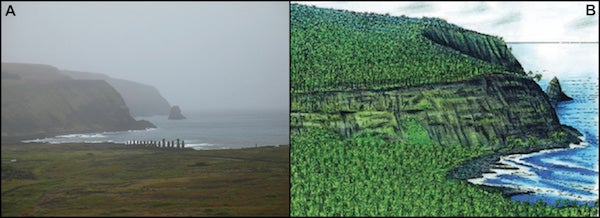
Comparison of present day Rapa Nui (A) to artist concept of ancient Rapa Nui (B). Credit: Jut Wynne (A) and Mieth and Bork 2004 (B)
Today, Rapa Nui is dramatically different from what the first Polynesians experienced. No stands of native vegetation remain. Of the remaining 43 endemic plant species, 35 species have been listed on a sensitivity gradient from rare to critically endangered. While there are 17 species of pelagic birds that form rookeries on the island, all ground-dwelling vertebrates have gone extinct. Prior to my research on Rapa Nui, only 21 endemic insects were known. Most of these animals had not been observed since their initial discoveries. As I was poring over this information, I posited most were likely now extinct. Yet, I was confident the last bastion of Rapa Nui’s ancient ecosystems would be insects—specifically cave-dwelling insects.
In July of 2008, I departed Santiago. As we flew out over the ocean, I remember peering down from my window seat to marvel at the vastness of the Pacific between mainland Chile and Rapa Nui. I could feel the remoteness. I remember thinking, “how could anyone live there? It’s so isolated.” As the plane prepared for landing, the captain notified the passengers of a storm brewing over the island. As I was disembarking the plane into the late evening air, the rain pelted my face. I could see a coconut palm bending in the distance to the unrelenting wind. At that point, I knew. I could live on Rapa Nui.
On my first trip to the island, I set out with a four-person team on a quest to find cave-adapted endemic insects. This work was largely proof-of-concept study fueling three more cave-research expeditions to the island between 2008 and 2011. All of this work focused on the highest concentration of caves on the island, an area two miles north of Hanga Roa—the only town on the island. The cave work culminated with an Explorers Club funded project in 2011 to specifically search the deepest parts of several caves for cave-adapted insects.
Their presence would be proof-positive of endemic and relict species of ancient Rapa Nui. While some troglobites (the fancy ecological term for cave-adapted animal) may be morphologically tricky to confirm their cave-obligate tendencies, others are quite easy. Telltale signs of troglobites are the lack of pigmentation, elongated legs and/or antenna, highly reduced to no eyes, and they’re often quite hairy. Shedding surface characters in favor of this subterranean tool kit can take a while, evolutionarily speaking. So, if we were to confirm the presence of cave-adapted insects, this finding would be strongly suggestive of them adapting to subterranean Rapa Nui. As a result, these critters would be of tremendous importance for future conservation efforts.
Alas, my research teams and I were unsuccessful. We did not find any endemic insects evolutionarily constrained to the deepest recesses of Rapa Nui caves. However, we did make several fascinating discoveries. We found eight island endemic species and two Polynesian endemics. Eight species were new to science! Ranging from tiny eye-straining springtails (Collembola) and book lice (Psocoptera) to the much larger roly polys (terrestrial Isopods), all of these animals were believed restricted to the cave environment.
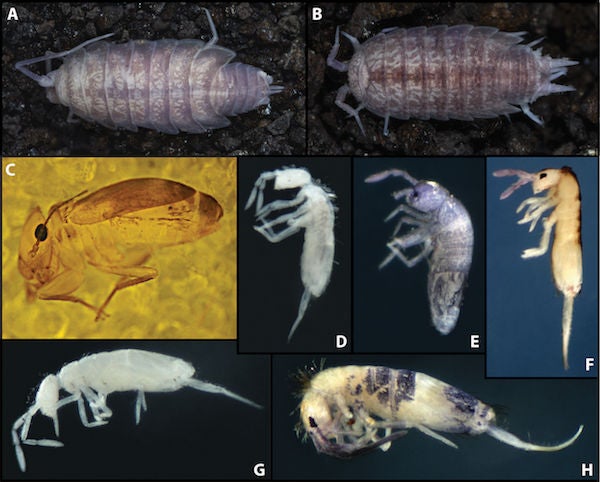
Island and Polynesian endemics from Rapa Nui. (A) Hawaiioscia rapui* (9.8 millimeters [mm] long); (B) Styloniscus manuvaka* (3.2 mm) from Taiti and Wynne 2015; (C) Cyptophania pakaratii* (2.8 mm) from Mockford and Wynne 2013; (D) Coecobrya aitorererere* (1.4 mm); (E) Pseudosinella hahaoteana* (0.8 mm); (F) Lepidocyrtus olena; (G) Coecobrya kennethi (1.1 mm); and (H) Seira manukio* (1.8 mm) from Bernard et al. 2015. *Represents new species discoveries. Credit: Wynne et al. 2014
We found these endemic species primarily in the fern-moss gardens within cave entrances and beneath cave skylights. They were hiding in plain sight! I suspect these habitats have been trampled by humans for centuries—first by the ancient Rapa Nui and more recently by adventure-seeking tourists.
We did find some individuals of the new endemic species lurking in the deepest reaches of two caves. Because these animals both appear restricted to cave entrances and also occurred in the deep cave, this may represent the earliest stage of an evolutionary shift toward cave adaptation. If this is the case, I will likely not be the one to prove it. I’ll have to leave this one for future cave ecologists. Such an evolutionary event may not be observable until long after I’ve moved on to higher exploration.
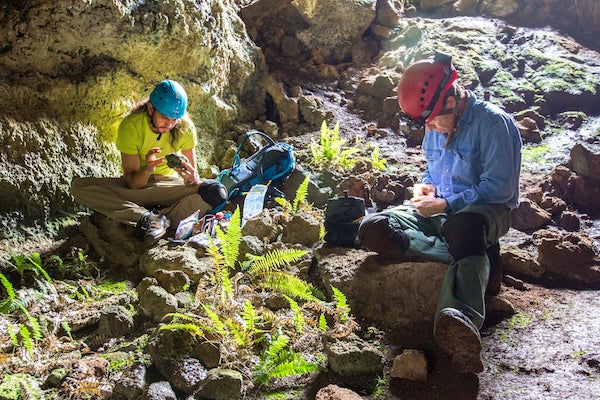
Rapa Nui naturalist Sebastian Pakarati (left) and the author collecting insects within the fern-moss garden of a cave entrance. Credit: Nicholas Glover
Colleagues and I later dubbed our newfound Polynesian endemics “canoe bugs.” The ancient Polynesians dispersed numerous plant species as they masterfully navigated the South Pacific, island-hopping and colonizing eastward. Just as we may tend to over-pack for a car-camping trip (just because we can), the Polynesians were no different. They had plenty of room in their massive, double-hulled voyaging canoes.
Instead of coolers full of food, a multitude of digital devices and other likely unnecessary sundries, they packed numerous items required for a transoceanic voyage including live plants. These “canoe plants” provided food, medicine and other uses such as materials for nets, sails and even fabric for clothing. Once these seafarers made landfall, they would grow these plants on the newly colonized island. Our “canoe bugs” were presumed stowaways within the soil of these “canoe plants.”
The discovery of 10 endemic insects believed restricted to caves leaves more questions than answers. Are they restricted to caves in one area, or do they occur in other caves across the island? Could they exist in other similarly protected surface habitats? With that in mind, do other endemic species persist in other protected surface habitats on the island as well?
My gravest concern is related to conservation. More than half of these new species were found in low numbers. Because of this, I believe most of these newly discovered animals to be imperiled. Rapa Nui is home to an overwhelming number of nonnative invasive insect species. Given that most of the island’s perishable and nonperishable goods are shipped from mainland Chile, there is a steady stream of opportunities for future non-native species introductions. I further mused whether these endemic insects are competing with the non-natives. And to what extent are they being preyed upon by non-natives?
I suspect the endemic insects are relicts of ecosystems long past, perhaps even ecological dead ends. If we don’t act to protect them, are they destined to go extinct?
This agglomeration of research questions compelled me to conduct an island-wide search for endemic insects. Much as NASA prescribes a “follow the water” approach in its search for evidence of life on Mars, I proposed to “follow the endemic plants” on Rapa Nui. I hypothesized that where there are endemic plants, there will be endemic insects. This research would zero in on caves, cliffs, coasts and crater lakes. The goal was to sample caves island-wide, rappel off thousand-foot coastal cliffs to examine relict endemic plant populations, comb the rocky and sandy coasts and examine the native vegetation within the three crater lakes. This was the most ambitious hunt for endemic insects ever conducted on the island.
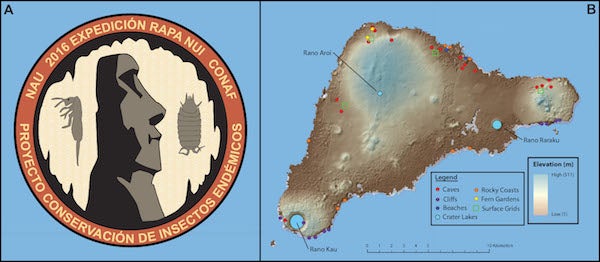
Mission patch (A) and study locations (B) for the 2016 Endemic Insects Expedition. (A) Base map: ASTER, NASA-JPL. (B) Design: Nicholas Glover and Jut Wynne
The project began in June of 2016. I embarked upon a three and a half month expedition to search for endemic insects in many of the hardest to reach places on the island. I called it the “backstage pass” to Rapa Nui. We sampled 47 sites across the island including 20 caves, 10 cliff faces, the three crater lakes, eight rocky coastlines, the two main beaches, four surface control sites, and two inland surface areas containing patches of native ferns. I collaborated closely with Parque Nacional Rapa Nui, the Rapa Nui Museum and local community members, as well as coordinated three international teams of citizen scientists and undergraduate students.
.jpg?w=600)
Team members peering into Rano Kau crater on the climb out. Credit: Jut Wynne
During our work, my teams experienced intense rainstorms (while dangling from a rope off a cliff), occasional blasts of cold temperatures pushed up from Antarctica, and even a wildfire. We also hiked in and out of the most formidable crater lake on the island, Rano Kau. In parts of the crater, the totora reeds were so thick around the crater lake that the person blazing the trail would dive onto the reeds, flatten them slightly, climb atop the slightly flattened reeds, and repeat. To stave off complete exhaustion, team members took turns leading the charge, rotating every 15 minutes.
While “adventure candy” was never in short supply, we also lived the inescapable beauty and rich culture of Rapa Nui. The rolling grassy hills festooned with moai with were our constant companions and the ocean was always nearby. The Rapa Nui people welcomed my teams and me with kindness and generosity.
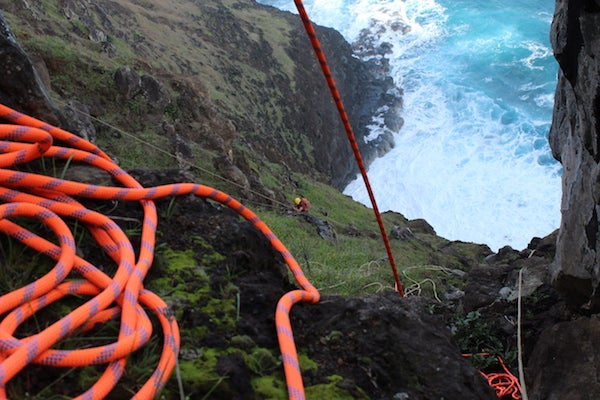
Arborist and technical rope expert, Byron Yeager ascending a cliff at Poike after sampling insects. Credit: Jut Wynne
Sharing food is an integral part of Polynesian culture. One of my most memorable eating occasions (and there were many) came during the cliff work. On several occasions, project co-director and park guard, Francisco “Pancho” Ika, would prepare fish, chicken and sweet potato on an open fire while we were working the cliffs. We often smelled the food cooking as we ascended the rope. When you're cold and wet, the thought of a warm meal makes you climb a lot faster!
The 2016 expedition was a smashing success. An unofficial goal was to double the number of endemic insect species known to Rapa Nui. This was reasonable. We started with a low number of presumed extant endemic insects (only 10 species). We were also sampling many habitats and areas that had never been studied. Our preliminary results suggest we may have at least eight new endemic species. We may very well have accomplished this goal!
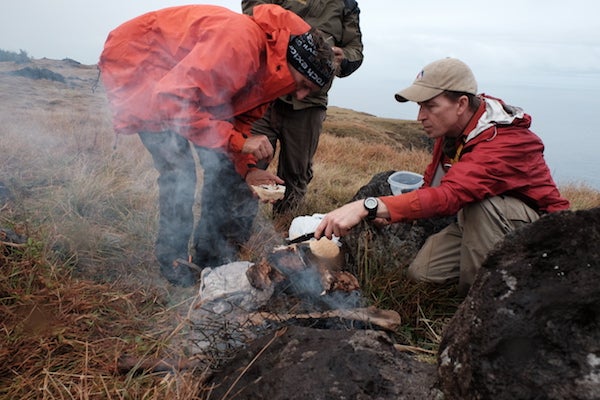
Drew Bristow and the author eating a late lunch (with Pancho in the background) after working on a cliff at Orongo. Credit: Byron Yeager
Formally describing a new species is serious business. One must compare and contrast specimens with all known closely related species. This is often an iterative and time-consuming process. Morphological characters must then be tediously illustrated. Researchers then write the paper, and it’s then subjected to peer review. Once these hurdles have been cleared, the paper is birthed to the world. At which point, the species is officially recognized as “new.”
Presently, we’re in the earliest “arm-waving” stage of this process. Based on photos and the locations where these animals were collected, collaborating taxonomists and I agreed that they warrant further examination. These eight species are quite possibly new. But, until we’ve run the gauntlet of scientific process, the most comfortable scientific ground to stand upon is calling these possible new species “curious.”
But here’s the kicker. We collected an estimated 20,000 specimens over the three and a half months of work on the island. I’d hazard a guess this assemblage likely holds more surprises. Especially when we consider small-bodied arthropods such as springtails and mites. These animals are difficult to examine in the field and making species-level identifications is often painstakingly tedious. I suspect there are more discoveries in store.
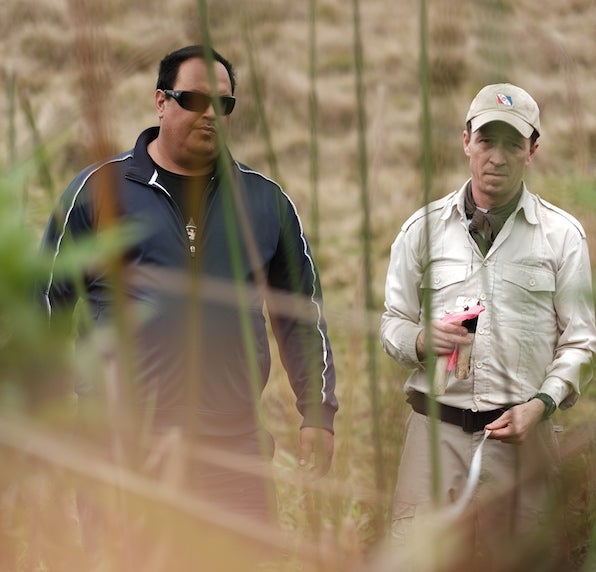
Pancho and the author deploying pitfall traps for capturing insects, Rano Aroi crater. Credit: Byron Yeager
Currently, a team of students is organizing, sorting and imaging these specimens. We hope to have all specimens processed by next spring. During this often glacial process, we periodically capture high-resolution images of the “curious” specimens, which we send to taxonomic specialists for further examination. If they get excited, we ship the specimens to them without delay.
I believe one of our greatest contributions was speaking with the Rapa Nui community concerning the importance of conservation and management of endemic insects on Rapa Nui. Pancho and I spent over two weeks presenting our work to the local community and discussing with them the importance of the island’s declining native species. We also gave two radio interviews and even aided in the production of a 15-minute video (in Spanish) summarizing the importance of this work.
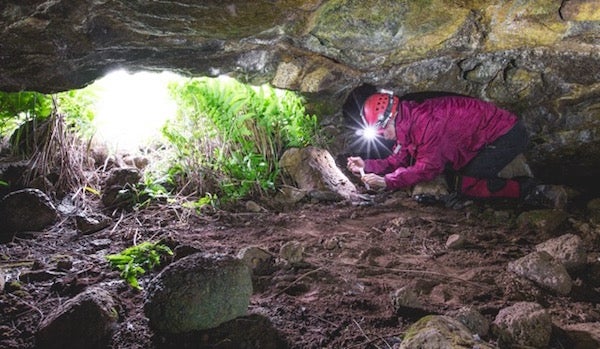
Biology undergraduate student Ben Shipley collecting insects from a cave entrance. Credit: Nicholas Glover
A dwindling handful of plants and bugs are all that remain of the island’s ancient ecosystems. If we can inspire the local Rapa Nui community to "adopt" these endemic species as their own (which they are), their chances of being protected are dramatically increased.
As we continue to process insect specimens and describe new species, I will continue to share our findings with the National Park and the island community. This information will trickle onto Rapa Nui over the next few years. As this occurs, my hope is that protection of the island’s native species will become an underpinning theme for natural resource conservation on Rapa Nui.
By the time I first reached Rapa Nui, my grandmother had already passed away. My fascination with Rapa Nui began with a childhood dream prompted by one story buried within a box of unwanted National Geographic magazines. Undoubtedly, she’d be quite amused to learn she shaped nearly a decade of research, contributed to numerous new species discoveries, and may have helped to protect endemic species on one of the most remote islands in the world.
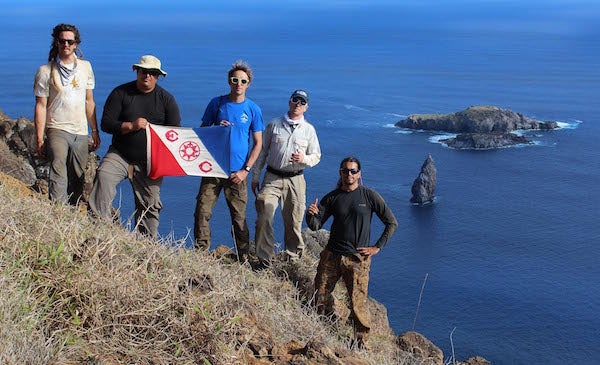
Explorers Club flag expedition photo with the cliff team. From left to right, Byron Yeager, Pancho Ika, Drew Bristow, the author, and Sebastian Pakarati. Credit: Sebastián Yancovic Pakarati
References:
Mieth, A. & Bork, H.R. 2004. Easter Island - Rapa Nui: Scientific Pathways to Secrets of the Past. Man and Environment 1. Ecology Center, Kiel University, Kiel.
Rolett, B. & J. Diamond. 2004. Environmental predictors of pre-European deforestation on Pacific Islands. Nature 431: 443–446.